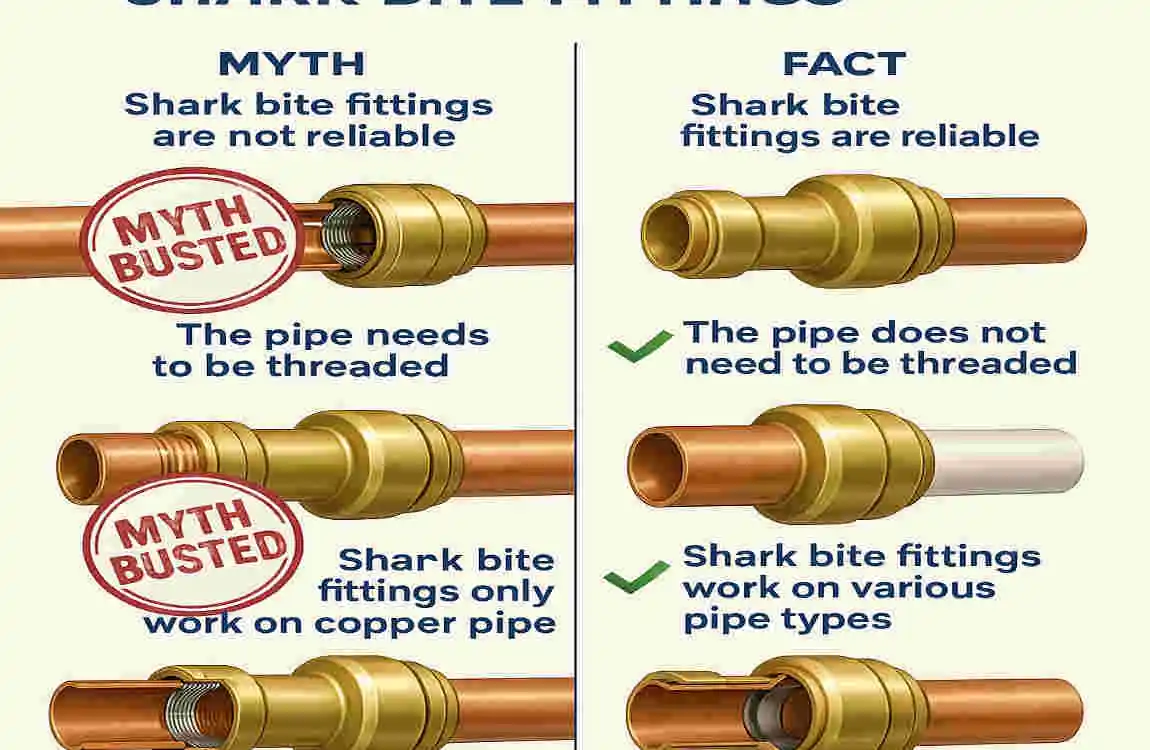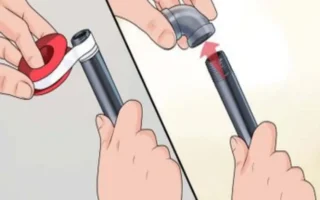Have you ever faced a plumbing emergency at home and wondered if there’s a faster, more straightforward solution than calling a professional? Modern homeowners deal with various plumbing challenges daily, from leaky pipes to complete bathroom renovations. The traditional approach often involves complex soldering, specialized tools, and considerable expertise.
Enter Shark Bite fittings – a revolutionary house plumbing solution that’s been transforming how both professionals and DIY enthusiasts approach pipe connections. These innovative push-to-connect fittings promise to make plumbing repairs and installations accessible to everyone.
Choosing the right plumbing fittings isn’t just about convenience. It’s about ensuring your home’s safety, preventing costly water damage, and maintaining an efficient plumbing system for years to come. Let’s dive deep into the world of Shark Bite fittings and discover whether they’re the right choice for your home.
What Are Shark Bite Fittings?

Understanding Push-to-Connect Technology
Shark Bite fittings represent a breakthrough in plumbing technology. These are push-to-connect plumbing connectors that allow you to join pipes without soldering, clamps, unions, or glue. Push the pipe into the fitting, and you’re done!
The genius behind these fittings lies in their simplicity. Unlike traditional methods that require flame torches, flux, and years of experience, Shark Bite fittings democratize plumbing repairs. They’re designed for anyone who can measure and cut a pipe.
Materials and Construction
These fittings aren’t just convenient – they’re built to last. High-quality materials ensure durability and reliability:
- Lead-free brass body: Provides strength and corrosion resistance
- Stainless steel teeth: Grip the pipe securely without causing damage
- EPDM O-rings: Create watertight seals that last for decades
- Protective plastic release collar: Allows for easy removal and reuse
The combination of these materials creates a fitting that’s both robust and versatile. Each component serves a specific purpose in maintaining a leak-free connection.
Common Types Available
Shark Bite offers an extensive range of fittings to handle virtually any plumbing situation:
Basic Connectors:
- Straight couplings for joining two pipes
- 90-degree elbows for corner connections
- Tee fittings for branching lines
- Reducers for connecting different pipe sizes
Specialized Fittings:
- Ball valves for shut-off applications
- Transition fittings for connecting different pipe materials
- Slip fittings for tight spaces
- Cap fittings for temporary or permanent pipe endings
Comparison with Traditional Methods
Traditional plumbing methods have served us well for decades, but how do they stack up against Shark Bite technology?
Soldering requires skill, patience, and proper safety equipment. You need flux, solder, a torch, and the ability to create perfect joints. One mistake can lead to leaks or pipe damage.
Compression fittings offer tool-free installation but require precise tightening. Over-tightening can damage pipes, while under-tightening causes leaks.
Threaded connections work well but require perfectly matched threads and proper sealing compounds. They’re also limited to specific pipe types.
Shark Bite fittings eliminate these complexities while maintaining professional-grade performance.
How Do Shark Bite Fittings Work?
The Push-to-Connect Mechanism Explained
The revolutionary design of Shark Bite fittings centers on their push-to-connect mechanism. When you insert a pipe, several things happen simultaneously to create a perfect seal.
First, the pipe passes through the release collar and encounters the stainless steel teeth. These teeth are angled to allow easy insertion but grip firmly against any pulling force. Think of them as tiny fingers that hold tighter the more you pull.
Next, the pipe slides past the teeth and makes contact with the O-rings. These rubber seals compress against the pipe surface, creating multiple watertight barriers. The fitting’s internal design ensures even pressure distribution around the entire circumference of the pipe.
You may also read (mastering wall venting home plumbing).
Internal Components Deep Dive
Let’s examine each component in detail:
The Stainless Steel Grab Ring:
- Contains precisely engineered teeth
- Provides a 360-degree grip on the pipe
- Resists pull-out forces up to manufacturer specifications
- Won’t corrode or weaken over time
EPDM O-Rings:
- Multiple rings provide redundant sealing
- Resistant to chlorine and other water treatment chemicals
- Maintain flexibility across temperature ranges
- Rated for decades of continuous use
The Release Collar:
- Enables fitting removal without damage
- Protects internal components during installation
- Color-coded for easy size identification
Step-by-Step Installation Guide
Installing Shark Bite fittings is remarkably straightforward:
- Cut the pipe squarely using a pipe cutter or saw
- Remove any burrs with a deburring tool or sandpaper
- Clean the pipe end to remove dirt and oxidation
- Mark the insertion depth using the depth gauge
- Push the pipe firmly into the fitting until it reaches the mark
- Test the connection by gently pulling to ensure it’s secure
The entire process takes seconds, not minutes or hours like traditional methods.
Compatibility Across Pipe Materials
One of Shark Bite’s greatest strengths is its universal compatibility. These fittings work seamlessly with:
- Copper pipes: Both rigid and flexible types
- PEX tubing: All three types (PEX-A, PEX-B, PEX-C)
- CPVC pipes: Chlorinated polyvinyl chloride
- PE-RT: Polyethylene of raised temperature resistance
This versatility makes them ideal for repair situations where you need to connect different types of pipe materials. No more worrying about finding the correct adapter or transition fitting.
Are Shark Bites Good for Plumbing? Pros and Advantages
Quick Installation Without Special Tools
The most apparent advantage of Shark Bite fittings is their incredible ease of installation. You don’t need:
- Soldering torches or flux
- Pipe wrenches or threading tools
- Glues or primers
- Years of plumbing experience
This accessibility transforms plumbing from a specialized trade into something any shark bite plumbing home owner can tackle. Weekend warriors can complete projects that previously required professional help.
Reusability and Workflow Flexibility
Unlike permanent connections, Shark Bite fittings can be removed and reused. This feature provides tremendous flexibility for:
- Temporary installations during renovations
- Testing different configurations
- Seasonal equipment connections
- Emergency repairs that need later refinement
Professional plumbers appreciate this flexibility when working in tight spaces or dealing with complex routing challenges.
Creating Reliable Watertight Seals
When properly installed, Shark Bite fittings create seals as reliable as any traditional method. The multiple O-rings provide redundancy, while the grab ring ensures the pipe can’t pull out under pressure.
These fittings undergo rigorous testing, including:
- Pressure tests exceeding typical household levels
- Temperature cycling to simulate real-world conditions
- Long-term durability assessments
- Pull-out force measurements
Perfect for Emergency Repairs
Picture this: It’s Sunday evening, and a pipe starts leaking. Hardware stores are closing, and plumbers charge emergency rates. With Shark Bite fittings in your toolbox, you can stop the leak in minutes.
No need to:
- Drain the entire system
- Wait for pipes to dry completely
- Heat the soldering equipment
- Call for expensive emergency service
Long-Term Durability
Shark Bite fittings aren’t just convenient – they’re built to last. Manufacturer warranties typically cover 25 years, reflecting confidence in their longevity. Real-world installations have shown:
- Consistent performance over decades
- Resistance to corrosion and mineral buildup
- Maintenance of seal integrity through temperature fluctuations
- Structural stability under constant pressure
Minimized Leak Risk for Amateurs
Traditional plumbing methods require skill to avoid leaks. Poor soldering technique, incorrect torque on compression fittings, or improper glue application all lead to failures. Shark Bite’s design minimizes these risks by:
- Eliminating technique-dependent processes
- Providing clear visual and tactile feedback
- Using multiple sealing mechanisms
- Allowing easy inspection and testing
Versatility in Applications
These fittings excel in both retrofit and new construction projects:
Retrofit Applications:
- Bathroom and kitchen remodels
- Water heater replacements
- Adding new fixtures to existing systems
- Repairing damaged sections
New Construction Uses:
- Rough-in plumbing where accessibility matters
- Temporary connections during phased construction
- Areas requiring future modifications
- Mixed-material installations
Potential Cons and Limitations of Shark Bite Fittings
Higher Initial Cost Considerations
Let’s address the elephant in the room: Shark Bite fittings cost more than traditional alternatives. A simple coupling might cost:
- Shark Bite: $5-10
- Copper coupling: $0.50-2
- PVC fitting: $0.25-1
This price difference adds up quickly in large projects. However, considering labor savings and reduced tool requirements, the total project cost often favors Shark Bite for smaller jobs.
Installation Location Restrictions
Not all locations are suitable for Shark Bite fittings. Many codes restrict their use in:
- Underground installations without access
- Inside walls without access panels
- Concrete encasements
- Direct burial applications
These restrictions stem from concerns about long-term accessibility for inspection and potential replacement.
Navigating Code Compliance Challenges
Plumbing codes vary significantly between jurisdictions. Some areas fully embrace Shark Bite technology, while others maintain restrictions. Common code concerns include:
- Requirements for accessible locations only
- Prohibitions in certain commercial applications
- Specific approval requirements for concealed installations
- Variations in approved pipe materials
Always check local codes before starting any project.
Temperature and Pressure Limitations
While suitable for most residential applications, Shark Bite fittings have limits:
Temperature Ratings:
- Maximum: 200°F (93°C)
- Minimum: 33°F (0.5°C)
- Not suitable for steam applications
- Reduced pressure ratings at higher temperatures
Pressure Ratings:
- 200 PSI at 73°F
- 100 PSI at 180°F
- Lower ratings for larger diameters
These limitations rarely affect typical home plumbing but matter for specialized applications.
Surface Preparation Requirements
Success with Shark Bite fittings depends on proper pipe preparation. Failures often result from:
- Pipes cut at angles rather than square
- Burrs or rough edges are damaging O-rings
- Paint, corrosion, or debris on pipe surfaces
- Deep scratches or gouges in the insertion area
Taking time for proper preparation prevents most problems.
Long-Term Reliability Concerns
While generally reliable, some professionals express concerns about decades-long performance:
- O-ring degradation in harsh water conditions
- Metal fatigue in grab rings under vibration
- Chemical compatibility with aggressive water treatment
- Unknown performance beyond the current installation age
These concerns, while largely theoretical, influence some professionals’ recommendations for critical applications.
Shark Bite Fittings vs. Traditional Plumbing Methods
Comprehensive Comparison Table
Feature Shark Bite Fittings, Traditional Fittings (Soldered, Compression)
Installation Time: Very fast, tool-free. Time-consuming, requires tools and skills
Skill Level Required: Beginner-friendly. Skilled labor is often needed
Reusability Yes, usually no
Cost per Unit Higher Lower per unit
Leak Risk Low if installed appropriately , Minimal, but it depends on skill
Code Compliance varies by region. Widely accepted
Temperature Rating Up to 200°F Higher for soldered joints
Pressure Rating 200 PSI, typical. Can exceed 200 PSI
Material Compatibility Multiple types often material-specific
Removal Difficulty Easy with tool Difficult to impossible
Space Requirements Minimal, varies by method
Weather Sensitivity: None during installation. Soldering is affected by wind/rain
When Each Method Shines
Choose Shark Bite when:
- Time is critical
- Access is limited
- Mixing pipe materials
- Planning future modifications
- Working as a DIY homeowner
Choose Traditional Methods when:
- Budget is extremely tight
- Installing in inaccessible locations
- Dealing with extreme temperatures
- Local codes require it
- Seeking maximum longevity assurance
Do Plumbing Codes approve Shark Bites?
Understanding Plumbing Code Landscape
Plumbing codes exist to protect public health and safety. In the United States, two principal model codes influence local regulations:
The International Plumbing Code (IPC) generally accepts push-to-connect fittings when they meet specific standards. Key requirements include:
- ASSE 1061 certification
- Accessible location installation
- The manufacturer’s installation instructions were followed
- Appropriate pipe material compatibility
The Uniform Plumbing Code (UPC) has historically been more restrictive but has evolved to accept push-to-connect fittings with conditions:
- Listed for the specific application
- Installed in accessible locations
- Used with approved pipe materials
- Meeting pressure and temperature requirements
Regional Variations and Local Amendments
Local jurisdictions often modify model codes, creating a patchwork of regulations. Common variations include:
Progressive Areas:
- Full acceptance in residential applications
- Allowance in concealed locations with access panels
- Approval for both hot and cold water systems
- Acceptance in multi-family housing
Conservative Jurisdictions:
- Restriction to exposed locations only
- Prohibition on new construction
- Limitation to repair work only
- Requirements for special permits
Checking Local Compliance
Before starting any project, verify local code requirements:
- Contact your local building department directly
- Ask specific questions about push-to-connect fittings
- Request written clarification if rules seem unclear
- Consider hiring a local plumber for code interpretation
- Document approvals for future reference
Residential Applications and Code Compliance
Most residential applications fall within code allowances:
Typically Approved Uses:
- Under-sink connections
- Water heater installations
- Bathroom fixture connections
- Accessible basement plumbing
- Exterior hose bib connections
Often Restricted Applications:
- In-wall installations without access
- Underground service lines
- Fire suppression systems
- Commercial kitchen applications
Best Practices for Using Shark Bite Fittings
Mastering Pipe Cutting and Preparation
Perfect preparation prevents poor performance. Start with the right tools:
For Copper Pipes:
- Use a tubing cutter for square cuts
- Rotate completely around the pipe
- Avoid hacksaws that leave rough edges
- Check for roundness after cutting
For Plastic Pipes:
- Use ratcheting PVC cutters for small diameters
- Employ a miter box and fine-tooth saw for larger pipes
- Ensure cuts are perfectly perpendicular
- Remove all plastic shavings
The Critical Deburring Step
Burrs are the enemy of O-rings. Even tiny metal fragments can cause leaks:
- Use a deburring tool designed for your pipe material
- Rotate several times , both inside and outside
- Run your finger along the edge to check smoothness
- Inspect visually for any remaining roughness
- Sand lightly if necessary for perfect smoothness
Ensuring Clean Installation Surfaces
Cleanliness directly impacts seal quality:
- Wipe pipes with a clean, dry cloth
- Remove any oxidation with fine sandpaper
- Clean away any paint or labels in the insertion area
- Check for deep scratches or gouges
- Use acetone for stubborn residues on plastic pipes
Verification Techniques After Installation
Trust but verify every connection:
The Pull Test:
- Grip the pipe firmly
- Pull with moderate force
- Feel for any movement
- Listen for air escaping
- Mark the pipe at the fitting edge
Pressure Testing:
- Turn on the water slowly
- Check for immediate leaks
- Monitor for several minutes
- Increase to full pressure gradually
- Inspect all angles of the fitting
Knowing When to Avoid Shark Bites
Certain situations demand traditional methods:
High-Temperature Zones:
- Near water heaters’ relief valves
- Steam radiator connections
- Solar hot water systems
- Commercial kitchen applications
Inaccessible Installations:
- Inside finished walls
- Under concrete slabs
- Buried service lines
- Cramped spaces preventing future access
Long-Term Maintenance Strategy
Proper maintenance extends fitting life:
- Annual visual inspections of accessible fittings
- Check for discoloration indicating overheating
- Monitor water pressure to avoid exceeding ratings
- Document installation dates for warranty purposes
- Keep spare fittings for emergency repairs
- Test shut-off valves connected with Shark Bites
Common Myths and Misconceptions About Shark Bite Fittings

Myth: Shark Bites Always Leak
This persistent myth stems from improper installation, not product defects. When Shark Bite fittings leak, investigation typically reveals:
- Pipes cut at angles rather than square
- Failure to deburr sharp edges
- Insufficient insertion depth
- Damaged or dirty pipe surfaces
- Exceeding pressure or temperature ratings
Properly installed Shark Bite fittings maintain leak-free performance for decades. Professional plumbers who follow best practices report failure rates comparable to or better than traditional methods.
Myth: They’re Only for Temporary Use
Manufacturer warranties tell a different story. With 25-year warranties and numerous installations approaching two decades of service, these fittings prove their permanence. The confusion arises because:
- They’re removable, suggesting temporary use
- Some codes require “accessible” locations
- Early adoption focused on repairs
- Marketing emphasized emergency applications
Today’s Shark Bite fittings are engineered for permanent installation, with materials and testing standards matching traditional methods.
Myth: Shark Bites Damage Pipes
The grab ring design specifically prevents pipe damage. Unlike compression fittings that can deform pipes when overtightened, Shark Bite’s teeth:
- Distribute gripping force evenly
- Penetrate only the surface layer
- Don’t compromise pipe wall integrity
- Allow repeated installation/removal
- Leave pipes reusable after removal
Industry Data and User Feedback
Real-world data contradicts these myths:
- Millions of fittings installed successfully
- Warranty claim rates below 1%
- Professional plumber adoption is increasing
- Building inspector acceptance is growing
- Insurance company approval for repairs
Independent testing confirms that performance matches or exceeds traditional methods when properly installed.
Cost Analysis: Are Shark Bites Worth the Investment?
Breaking Down the True Costs
Initial purchase price tells only part of the story. Consider this comprehensive analysis:
Shark Bite Installation Costs:
- Fitting: $5-15 depending on type
- Tools needed: Pipe cutter ($10-30)
- Time: 5 minutes per connection
- Skill required: Minimal
Traditional Soldering Costs:
- Fitting: $0.50-3
- Tools: Torch, flux, solder, safety equipment ($50-150)
- Time: 15-30 minutes per connection
- Skill: Significant experience needed
Labor Savings Calculations
For DIY projects, labor savings are immediate:
- No learning curve expenses
- No ruined fittings from failed attempts
- No call-out fees for professionals
- Immediate problem resolution
For professionals, efficiency gains include:
- Faster job completion
- Fewer callbacks for leaks
- Reduced tool transportation
- Ability to handle more daily calls
Scenario-Based Value Analysis
Emergency Repairs: Weekend plumber call: $200-500 Shark Bite fitting and tool: $20-40 Savings: $160-480
Bathroom Remodel (10 connections): Professional labor for soldering: $500-800 Shark Bite fittings DIY: $50-150 Savings: $350-750
Rental Property Maintenance:
- Quick repairs between tenants
- No scheduling professional visits
- Immediate response to issues
- Reduced water damage risk
Long-Term Cost Considerations
Factor in these long-term elements:
Potential Savings:
- No leak damage repairs
- Reduced insurance claims
- Flexibility for future changes
- Reusability for modifications
Potential Costs:
- Higher replacement fitting prices
- Possible code compliance updates
- Professional inspection requirements
Customer and Professional Reviews of Shark Bite Fittings
Homeowner Experiences
DIY enthusiasts consistently praise Shark Bite fittings for:
“I fixed my leaking water heater connection in 10 minutes on a Sunday night. Would have cost me $300 for an emergency plumber!” – Sarah M., Homeowner
“As someone with zero plumbing experience, I successfully replumbed my entire bathroom. The fittings gave me confidence to tackle the project.” – Mike T., First-time DIYer
Common positive themes include:
- Confidence-building for novices
- Time savings on weekend projects
- Successful emergency repairs
- Ability to modify mistakes easily
Professional Plumber Perspectives
Industry professionals offer nuanced views:
“I keep Shark Bites on my truck for specific situations. They’re invaluable for tight spaces and mixed-material transitions.” – John D., Licensed Plumber, 20 years experience.
“For accessible repairs and customer-requested quick fixes, they’re perfect. I still prefer soldering for new construction rough-ins.” – Maria L., Master Plumber.
Professional advantages cited:
- Efficiency in service calls
- Customer satisfaction with quick repairs
- Reduced callbacks for minor leaks
- Flexibility in challenging installations
Success Stories from Real Installations
The Water Heater Emergency: A family’s water heater failed on Christmas Eve. Using Shark Bite fittings, they installed a replacement themselves, saving the holiday and hundreds in emergency fees.
The Rental Property Solution: A landlord standardized on Shark Bite fittings for all accessible repairs, reducing maintenance response time from days to hours and improving tenant satisfaction.
The Remodel Revolution: A couple completed their entire kitchen plumbing renovation over two weekends, something impossible with traditional methods, given their skill level.
Learning from Failures
Honest analysis includes failures:
Common failure scenarios:
- Rushing installation without proper prep
- Using on damaged or painted pipes
- Exceeding temperature ratings near water heaters
- Ignoring local code requirements
These failures consistently trace back to user error rather than product defects, underscoring the importance of adhering to best practices.
Alternatives to Shark Bite Fittings
Other Push-to-Connect Brands
Competition drives innovation in the push-to-connect market:
Apollo/Tectite:
- Often lower priced
- Similar performance ratings
- Different internal design
- Growing professional acceptance
Watts Quick-Connect:
- Commercial-grade options
- Higher temperature ratings
- Specialized fitting varieties
- Strong contractor support
ProBite:
- Budget-friendly option
- Basic fitting selection
- Adequate for simple repairs
- Limited availability
Traditional Soldering Remains Viable
Soldering isn’t obsolete and excels for:
- Maximum temperature applications
- Permanent installations
- Lowest material costs
- Traditional craftsmanship pride
Modern improvements include:
- Lead-free solder requirements
- Better flux formulations
- Improved torch designs
- Safety equipment advances
Compression Fittings for Specific Uses
Compression fittings offer a middle ground:
Advantages:
- No special tools required
- Removable and adjustable
- Work with multiple materials
- Time-tested reliability
Best Applications:
- Shut-off valve connections
- Fixture supply lines
- Temporary installations
- Where a slight adjustment helps
Modern Quick-Connect Evolution
New technologies emerging:
Press-Connect Systems:
- Professional-grade permanence
- Specialized tool required
- Faster than soldering
- Growing code acceptance
Expansion Fittings:
- PEX-specific technology
- Extremely reliable connections
- Higher initial tool cost
- Professional preference growing
Choosing the Right Alternative
Match the method to your needs:
- Budget critical? Traditional soldering
- Time critical? Push-to-connect
- Permanent installation? Press or solder
- Frequent changes? Compression fittings
- PEX only? Expansion fittings
Conclusion: Are Shark Bites Good for Plumbing in Your Home?
Recapping Key Advantages
Shark Bite fittings have revolutionized home plumbing by making it accessible, efficient, and reliable. Their primary advantages include:
- Instant installation without special skills
- Universal compatibility across pipe materials
- Proven reliability with proper installation
- Reusability for modifications
- Code compliance in most residential applications
These benefits make them excellent choices for homeowners, DIY enthusiasts, and professionals seeking efficiency.
Understanding the Limitations
Every technology has boundaries, and Shark Bite fittings are no exception:
- Higher per-unit costs impact large projects
- Temperature and pressure ratings limit some applications
- Code restrictions vary by location
- Long-term performance beyond 20 years remains unproven
- Proper installation remains critical
Making Your Decision
Consider these factors when deciding if Shark Bites are right for your project:
Choose Shark Bites when:
- You need immediate repairs
- Working in accessible locations
- Connecting different pipe materials
- Planning future modifications
- Valuing time over material costs
Consider alternatives when:
- Working with tight budgets on large projects
- Installing in inaccessible locations
- Dealing with extreme temperatures
- Local codes prohibit their use
- Seeking 50+ year installations
Final Recommendations
For most homeowners, Shark Bite fittings represent an excellent investment in plumbing capability. They transform intimidating plumbing projects into manageable tasks while maintaining professional-quality results.
Keep these fittings in your toolkit for:
- Emergency repairs
- Weekend projects
- Fixture upgrades
- Seasonal connections
Consult professionals for:
- Major replumbing projects
- Code compliance questions
- Critical system components
- Warranty considerations
Taking Action
Ready to experience the convenience of Shark Bite fittings? Start small with a simple repair project to build confidence. Keep a selection of standard fittings on hand for emergencies. Most importantly, always follow manufacturer instructions and local codes for safe, reliable installations.
Whether you’re a seasoned DIYer or a complete novice, Shark Bite fittings can make your next plumbing project faster, easier, and more successful. The question isn’t whether Shark Bites are good for plumbing – it’s whether you’re ready to join the push-to-connect revolution.
Additional Resources and References
Official Installation Resources
Manufacturer Guides:
- SharkBite official installation videos on YouTube
- Downloadable PDF installation guides
- Mobile app with pipe depth calculator
- Technical support hotline for questions
Code Compliance Resources
Building Code References:
- International Code Council (ICC) website
- Local building department contacts
- ASSE 1061 standard documentation
- State plumbing board resources
Recommended Tools
Essential Tool Kit:
- Pipe cutter: Ridgid or Milwaukee models
- Deburring tool: General Wire Spring Company
- Depth gauge: SharkBite or homemade
- Removal tool: SharkBite disconnect clip
Where to Purchase
Retail Options:
- Home Depot: Widest selection
- Lowe’s: Competitive pricing
- Local plumbing supplies: Professional guidance
- Amazon: Convenience and reviews
- Plumbing wholesalers: Bulk pricing
Online Resources:
- SharkBite.com: Direct from manufacturer
- SupplyHouse.com: Professional-grade selection
- Ferguson.com: Trade pricing available
- PlumbingSupply.com: Specialty fittings
Remember, successful plumbing projects begin with high-quality materials, thorough preparation, and adherence to proven techniques. Shark Bite fittings can be an excellent choice when used appropriately within their design parameters and local code requirements.
You may also read (a guide to replacing plumbing in your home).




